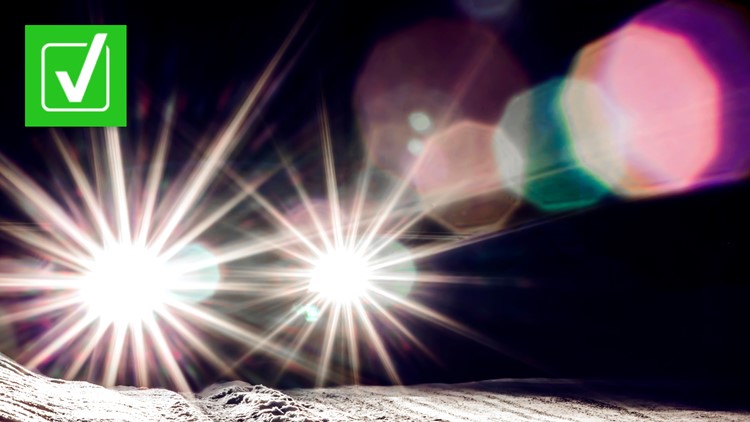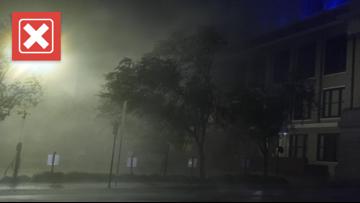Many people are convinced the car headlights of today are brighter than ever before. Some people go a step further, claiming that headlights are now “too bright” and blinding other drivers on the road as a result.
Janet submitted a question to VERIFY wondering if some headlights appear brighter than others.
THE QUESTION
Do many newer car headlights appear brighter than older car headlights?
THE SOURCES
- Insurance Institute for Highway Safety (IIHS)
- National Highway Traffic Safety Administration (NHTSA)
- Code of Federal Regulations
- Consumer Reports
- Matt Brumbelow, senior research engineer at the IIHS
- Greg Brannon, director of automotive engineering for AAA
- Karl Citek, Ph.D., O.D., optometrist who teaches classes on optics and vision at Pacific University
THE ANSWER
Yes, many newer car headlights appear brighter than older car headlights.
WHAT WE FOUND
The human eye is more sensitive to white or blue lights, such as those in the LED and high-intensity discharge (HID) headlights that are more common in newer cars, than it is to yellow lights, such as halogen headlights found in most older cars. This difference in sensitivity makes many newer headlights appear brighter.
Our eyes are more sensitive to yellowish-green lights during the day, but become more sensitive to bluish light at night or in our peripheral vision, says Karl Citek, Ph.D., O.D., an optometrist who teaches classes on optics and vision at Pacific University.
That means if a blue or white headlight and a yellow headlight produce the same amount of light, the blue or white headlight will appear brighter to you at night, when people are using their headlights, Citek said.
All car manufacturers, regardless of the headlights they use, must follow federal regulations that limit how bright low-beam headlights are allowed to be, a regulation that’s remained largely unchanged since the 1970s.
Halogen bulbs have been used in headlights since the 1970s, the Insurance Institute for Highway Safety (IIHS) says. While halogen headlights are still the most common among all the cars on the road today, LED headlights have become increasingly popular, Consumer Reports said in a 2019 article. Consumer Reports said 86% of the 2019 models it tested had LED headlights.
A 2008 National Highway Traffic Safety Administration (NHTSA) research report found that bluish headlight beams didn’t actually blind other drivers any more than yellowish headlight beams, but bluish headlights were more uncomfortable to other drivers nonetheless. Citek said our sensitivity to blue lights is a major reason for this.
But color is just one of several factors that contribute to why some headlights appear brighter or blinding to oncoming drivers. The most significant factor, according to experts, is misaimed headlights.
Matt Brumbelow, senior research engineer at the IIHS, and Greg Brannon, director of automotive engineering for AAA, say many headlights in both new and old cars appear blinding because of the direction or “aim” of the headlights. If a headlight’s beam is pointed too far up, it’s going to be in oncoming drivers’ eyes.
The 2008 NHTSA report found that 62% of in-use vehicles at the time had at least one misaimed headlight.
“The vast majority of headlights are not adjusted properly,” Brannon said. “Even modern headlight systems need to be adjusted sometimes, particularly after you’ve been in an accident or part of the system has been replaced.”
The IIHS, NHTSA, Brumbelow, Brannon and Citek also named several other factors that can make a headlight appear brighter or more blinding to other drivers:
Beam concentration: Some headlights from the last two decades have designs that concentrate the light’s beam more precisely. This gives the driver more visibility when aimed correctly, but can also make the lights seem even brighter and more blinding to oncoming drivers when the beam is pointed incorrectly.
Headlight height: Headlights that are mounted higher, which is typically the case on vehicles like trucks or SUVs, are closer to the eye level of drivers of lower cars and appear brighter.
Aftermarket headlights: Some people modify their cars with different headlights. Some are not compatible with the car and create a brighter, higher-intensity light than what’s legally allowed.
Wandering eyes: If you look directly at a headlight, even for only a moment, it’s going to appear brighter than it would otherwise.
Age: Our eyes get worse as we age. Aging eyes are more sensitive to glare, making headlights on other cars appear brighter as we get older.
Carmakers have been working on improving headlights while also reducing their glare. A recent change in regulations might help them.
In 2022, the NHTSA began allowing carmakers to use adaptive headlight technology that automatically changes brightness or direction of the beams based on a driver’s surroundings. If there’s oncoming traffic, the lights will dim in the direction of that traffic. If there’s a driver directly ahead, the lights will dim all around. Otherwise, it will keep the car’s high beams up.
Experts believe this will significantly improve headlights for all drivers on the road.













